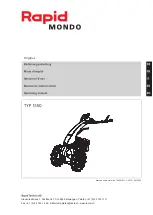
CPT Autopilot Operation Manual
© 2018 CPT AUTOPILOT INC.
VERSION 22
PAGE 15 OF 21
Maintenance and Adjustments
General Maintenance and Storage
After use, rinse salt off; lightly spray with fresh water and lightly wipe the CPT down with a cloth and dry it.
Do not use alcohol or solvents to clean the motor box or control box as they may remove the paint and
graphics. Store the unit in a dry place when not in use, or protect it with a wheel/binnacle cover or other
appropriate cover. When the boat is laid up, take the pilot home if possible. Do not store it in a damp locker
during lay-up, or a location subject to flooding or damp conditions. When stored, store control box and motor
boxes on their sides, with the control dials and clutch facing sideways, not facing up or down.
WARNING! Do not store the CPT in the bilge or any locker liable to flooding, leaking, or standing water
.
Belt Tension
Unlock the clamp lever and slide the motor unit down on its mounting
bracket slots with your hands to tension the belt. Pull the belt snug by
putting downward pressure on the motor box with your hand and then
locking the clamp lever. The clamp lever tightness can be adjusted by
unlocking the lever and tightening or loosening the knurled thumb nut.
Do not over-tension the belt. Excessive tension causes clutch wear,
makes the clutch difficult to operate and may damage the motor shaft.
Over-tensioning also removes any beneficial “give” in the drive system.
If it doesn't slip it is tight enough.
An over-tightened belt will not
allow any give
; a less tensioned belt will give warning of heavy loads or
striking the rudder-stops with a skip and thump. The hose-clamps on
the pedestal bracket may need to be tightened after the foam scratch
pads compress. Pedestal installations using a reverse mounting plate
may sometimes need the bracket directly fastened to the pedestal with
screws if the hose-clamps slip under heavier loads.
Pulley and Clutch Maintenance
The drive pulley is held in one of two positions (engaged or disengaged)
on its shaft by a detent (spring-loaded ball), which fits into one of two
grooves on the shaft. All parts are made of Delrin, Nylon or stainless
steel.
Most clutch wear is caused when hand-steering under high belt tension
without lubrication. Lubricate the drive pulley and shaft periodically. Salt water may leave salt crystal build-up
in the detent. The Delrin drive pulley should be removed from the drive-plate, cleaned and oiled or greased
periodically—more often in severe or heavy use conditions.
If the autopilot will not be steering for awhile, remove the belt from the small pulley and hang it over the
binnacle or wheel shaft. This will lessen wear and prolong the life of the clutch when hand steering.
Each season service and lubricate the clutch/drive pulley. You should not remove the drive-plate unless the
broken head of a shear-pin is stuck behind the drive-plate.
·
Loosen tension on the drive belt and remove belt from the small pulley.
·
Remove the two screws from the back of pulley cap; these are the shear-pins. (The black, grooved grip
used to engage and disengage the clutch is the pulley cap. The screws are the machined shear pins.)
Do not
attempt to remove the shear-pins if the pin ends are bent. Reach and straighten them with long-nosed
pliers or a small vise grip first.
·
Remove pulley cap.
·
Remove stainless steel retaining clip from its groove at the end of the shaft.







































